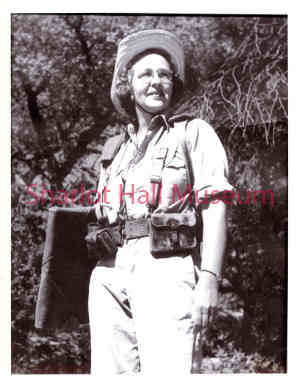By Katherine Krieger Pessin
(One of the first women to be granted a PhD in geology was Florence Bascom in 1893 and, at that time, any woman in the field was delegated to office work including hand-coloring maps and illustrating technical publications. In fact, when she attended college geology classes she had to sit behind a screen so as not to disrupt her male peers! Later, she, as well as others, became teachers and assistants to male geologists. Florence Bascom was the first woman geologist hired by the U.S.Geological Survey in 1896. It was rare for a woman to become a field geologist. Medora Hooper Krieger followed in the footsteps of Bascom, joining the USGS in 1944 and was an inspiration to other women geologists of her time. By 1952, only 2% of the geoscience workforce in the USGS was female and only a handful were field geologists. By 2004, the numbers increased to 20%. Source: USGS EEO office.)
My mother, Medora Hooper Krieger, was one of the most prolific geologic mappers at the USGS during the twentieth century. Although her early training and work was in the eastern United States, particularly in the Adirondack Mountains of New York, she is known mostly for her 35 years of mapping in the State in Arizona, where she did what was considered a man’s job in a world that was considered a man’s world.
 Medora was born in 1905 in Ticonderoga, New York. Her father, grandfather and two uncles were all mining engineers. She earned her bachelor’s degree in geology at Vassar College in 1928, and then attended Columbia University for her master’s degree and later her PhD.
Medora was born in 1905 in Ticonderoga, New York. Her father, grandfather and two uncles were all mining engineers. She earned her bachelor’s degree in geology at Vassar College in 1928, and then attended Columbia University for her master’s degree and later her PhD.
She met her future husband, Philip Krieger, at Columbia University where he had just finished his PhD in geology and was an assistant Professor of Geology at Columbia. They were married in 1931. She worked for the New York Geological Survey until I was born in 1939. Following the death of her husband in an automobile accident in 1940, she taught at Mount Holyoke College in Massachusetts from 1942-1944.
In the summer of 1944, she joined the U.S. Geological Survey in Washington, D. C. Her work there involved office work, not fieldwork, and like so many geologists, she loved the outdoors and had joined the Survey hoping to do field mapping. But at that time the Survey did not allow women to work in the field, thinking the work was too hard and too rough for a woman.
Then in 1947, the Survey began to send its workers to various places in the United States, rather than having everyone stationed in Washington, D. C. In the summer of 1947, she was sent to the Southwestern Geology branch in Prescott, Arizona. At this time the Survey had a number of geologists studying copper deposits. Her original assignment was to map the region "around" the Bagdad Mine, but not in or near the mine itself because the miners objected to a woman. She was to do detailed mapping to contribute to the overall knowledge of the area. From this beginning she went on to map a total of 12 topographic quadrangles in Arizona, (including the Prescott and Paulden quadrangles) of which she was either first author or co-author. Quadrangles vary in size, but most in this area are approximately 250 square miles and she covered these mostly on foot.
The author of this article, Medora’s daughter, Katherine, lives in Prescott.
This and other Days Past articles are available on sharlothallmuseum.org/archives and via RSS e-mail subscription.
Your stories and experiences are important. The public is welcome to submit articles for Days Past consideration. Please contact Scott Anderson at Sharlot Hall Museum Archives at 445-3122 for information.


